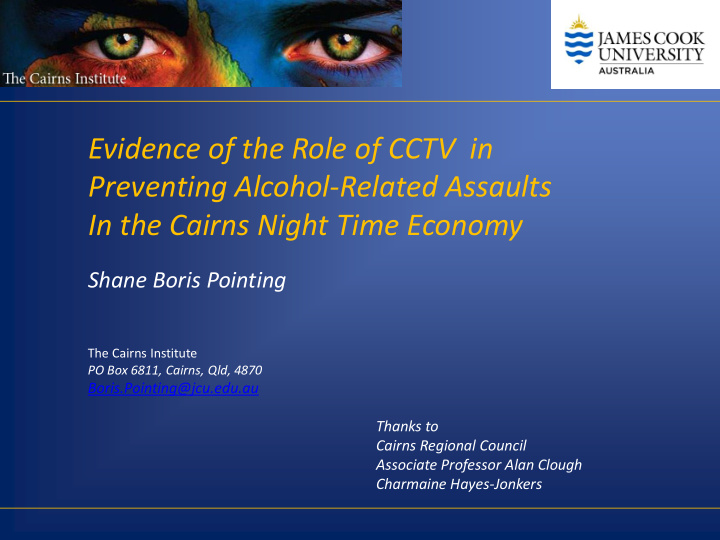



Evidence of the Role of CCTV in Preventing Alcohol-Related Assaults In the Cairns Night Time Economy Shane Boris Pointing The Cairns Institute PO Box 6811, Cairns, Qld, 4870 Boris.Pointing@jcu.edu.au Thanks to Cairns Regional Council Associate Professor Alan Clough Charmaine Hayes-Jonkers
Seminar Overview 1. Cairns open-space CCTV system 2. Background to Study 3. Interruption of Assaults 4. Economic Cost Effectiveness Analysis (cost to community) 5. Realist Evaluation method
Cairns Open-Space CCTV system to limit assaults
Technological Capability Note the sign behind the truck
CCTV Real-time Communications System Police (Comms) Camera Police Security Room (radio) (venues) Security (Street)
Alcohol Assault Co-ordinated data collection tool • Reported • Place • Injury Severity • Time • Place • Demographic • Time • Unreported ED Police Venues CCTV • Place • Place • Unreported • Time • On street only
Which showed us Incidents of person-to- person violence (‘alleged assault’) in the Cairns Late Night Entertainment Precinct: June 2011 Emergency incidents observed Department by CCTV data Unsure if incidents seen alcohol-related by both CCTV or occurring in & QPS ‘Yes’ the CBD Police charges of believed to be alcohol-related alcohol-related assault and occurred in the CBD Security Data Including with ‘alcohol not involved’ 123 incidents counted
CCTV Real-time Communications System Police (Comms) Camera Police Security Room (radio) (venues) Security (Street)
Interruption of Assaults Examined CCTV camera operator reports and observed footage of recorded assaults Nine days in late-August (2010) and thirteen days over Christmas/New Year (2010-11) Assaults: 30 in 22 Days
Interruption of Assaults Assaults: 30 in 22 Days a) Happened too quickly for camera operators to direct street security to intervene: 13 (43%) b) Operators alerted street security who then intervened to curtail the violence or prevent its escalation: 12 (40%) c) Potential to intervene to prevent the initiation of violence: 5 (17%)
Realist Evaluation method Context Outcomes Mechanisms One strength of RE is facilitation of scientific hypotheses Another is policy and practice contribution
CCTV Real-time Communications System Police (Comms) Camera Police Security Room (radio) (venues) Security (Street)
Applied Realist Evaluation Camera room Context operations Camera operator training Real time communications network 40% Outcomes 17% Body language Behavioural predictors Operator attention Mechanisms
Continuous Quality Improvement Data Provided Training Footage & Data workshop CCTV sampled & analysed Results fedback Intervention points refined
ECONOMIC ANALYSIS: Cost benefit Estimated costs to the community saved over 22 days in documented incidents in which the CCTV system intervened (2005 dollars) Incidents where Hospitalisation Severe/moderate No injury would Total over 22 Total over days ($) assault was would have injury would have have occurred Calendar limited resulted with no occurred with no with no Year intervention intervention intervention 12 0 ($0) 0 ($0) 12 ($4,560) $4,560 $ 75,654 $17,820 12 0 ($0) 3 ($14,400) 9 ($3,420) $ 295,633 12 1 ($16,000) 3 ($14,400) 8 ($3,040) $33,400 $ 554,106 12 3 ($48,000) 3 ($14,400) 6 ($2,280) $64,680 $1,073,041 $31,080 12 0 ($0) 6 ($28,800) 6 ($2,280) $ 515,617 12 1 ($16,000) 6 ($28,800) 5 ($1,900) $46,700 $ 774,753 12 3 ($48,000) 6 ($28,800) 3 ($1,140) $77,940 $1,293,024
Context of open-space urban CCTV system defined A. Precise system outcomes B. Police involvement C. Camera room staff and operations D. Camera operator training E. Community information strategy & strategic communication networks F. Real-time communication networks G. Referral and outcome recorded H. Regular internal audit and external evaluations I. Legislative and regulatory requirements met
DIAGRAM OF REALIST EVALUATION OF CCTV INTERVENTIONS Directed CCTV control Response room operations M C C M O O M C Community Data Combined Alcohol- O O Education Accuracy Related Assaults Strategy C M O O M C Strategic C Police M Intelligence Involvement Sharing with partners CCTV NIGHT TIME ECOLOGY
Using Realist Evaluation for accuracy of data entry Defined Data Entry Context Stable Mechanisms Audit of Data accuracy Camera Outcomes Operators (Study 1.2)
CCTV: Accuracy of Incident Type categorisation 100% 90% 80% Inaccurate 70% 60% Almost 50% 40% Accurate 30% 20% 10% 0% Period 1 (Sept 2010) Period 2 (Xmas & NY 2010/11) Baseline Follow-up
Continuous Quality Improvement in a Realist Evaluation method Data Provided Training Footage & Data workshop CCTV sampled & analysed Results fedback Intervention points refined
Current Research CAMERA OPERATORS Some Assaults in LNEPs are a four stage process (Barker, 2010) Viewers of CCTV footage can predict the outcome of a behavioural sequence more than 80% of time (Troskianko et al, 2009) COMMUNITY EDUCATION Identify social mechanisms of CCTV within night time economy patrons
Thank you
Recommend
More recommend